WiZ Smart Lighting Review: Low cost, lots of features
Verdict
Thanks to a wide range of smart bulbs, fittings and light strips, the WiZ Smart Lighting range can fit into most homes easily. Optional movement sensors and remotes give WiZ more control options than other Wi-Fi smart lighting ranges, too. We were impressed with the quality of the light and bulbs, making this a great upkeep smart lighting system.
Pros
- Splendid range of bulbs
- Good pricing
- Optional concrete controls
Cons
- After powering on, bulbs can be irksome to announced in app
- Non as many control options as Hue
Availability
- United kingdom RRP: £9.99
- U.s.a. RRP: $nine.99
- Europe RRP: €ii.99
Primal Features
- Bulbs You lot tin buy most common bulbs, including B22, E27, E14 and GU10. Additionally, WiZ sells dedicated calorie-free fittings, calorie-free strips and lamps.
- Connection These bulbs connect via Wi-Fi.
Introduction
Philips Hue has long been the gold standard in smart lighting, but information technology'south an expensive system to purchase into. If y'all're looking for something a bit cheaper, then the WiZ smart lighting organisation could exist for you. Developed by Signify, the company that owns Hue, WiZ has a large range of bulbs, is cheaper to purchase and, as it uses Wi-Fi, doesn't demand a Bridge to get the most out of it.
Quality bulbs and a decent app make this budget lighting system stand out from the other Wi-Fi competition, but the app and range of accessories aren't as wide as with Hue. If you simply want a couple of smart bulbs, then this is a good system only I'd go with Hue for larger installations, even if it is more expensive.
Bulbs
- Most common bulbs supported
- Range of dedicated light fittings
- Plug-in light strips
Most budget smart lighting brands don't have a very wide choice of bulbs, merely WiZ is different, supporting most of the mutual connectors including GU10, E27, E14 and B22. That's the same blazon of connectors as available on Hue. In particular, it'due south proficient to run across the E14 connector, as this is typically used for smaller desktop lamps and some light fittings.
Bulbs are available in three types: dimmable, tunable white (typically a warm 2700K to cold 6500K light) and full colour (does everything the other bulbs practise plus you go the full range of millions of colours to choose from.
While Hue bulbs typically range between £29.99 for dimmable and £54.99 for colour, WiZ bulbs start at around £nine.99 for the dimmable model and tiptop out at around £xiv.99 for the total-color models. That makes WiZ'southward range a lot cheaper.
WiZ also has a serial of filament bulbs, available in the tuneable white series. They go from cold white to warm white, as well equally dimming, which is an improvement over the Hue version, which dims just and has a set colour temperature.
In addition, WiZ also has a range of lite fittings, including spotlights and ceiling lamps. The range here isn't as practiced equally Hue's but at that place's more than choice than with other Wi-Fi brands.
There's likewise an LED lightstrip, available as a 2m strip, plus you tin buy 1m extension cables to create a total maximum length of 10m.
There are no specific outdoor products for WiZ, so if yous want to low-cal up your garden, yous'll either accept to install bulbs in outdoor fittings (and hope your Wi-Fi is good plenty to piece of work outside) or go with Hue instead.
Switches and sensors
- Motion sensor
- Optional remote control
- Smart plug
While the main benefit of smart lightning might be decision-making it from an app or using your voice, there are times when it'south but easier to use a dedicated switch. The huge range of wireless switches for Hue, from the Hue Wall Switch Module to the Senic Friends of Hue Smart Switch, is what makes that organization stand out. Almost of the competition doesn't provide remotes, merely WiZ has a express pick.
Using a low-power RF protocol to communicate straight with a seedling, in that location's a choice of the Movement Sensor to turn your lights on or off automatically, and the WiZmote remote control.
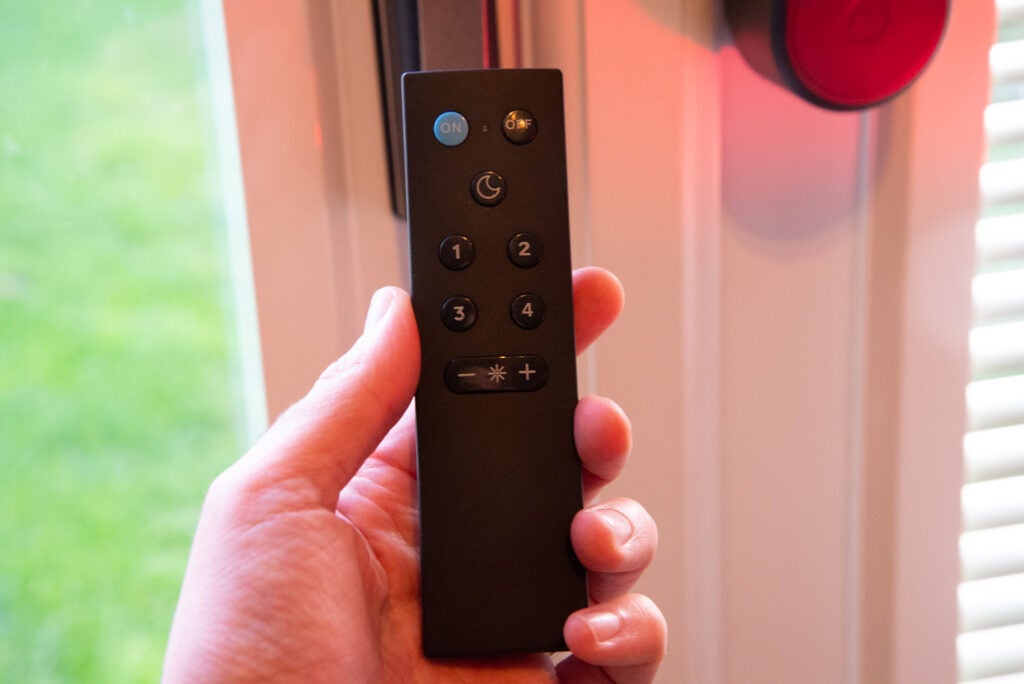
The remote is a useful tool to have, say leaving it sat on a table, giving you control without having to reach for your phone. It's a piffling basic (information technology looks like the kind of inexpensive remote y'all get with a budget speaker), simply gives you lot on/off control, dimming, plus shortcuts to turn on the nighttime calorie-free way and your choice of four scenes.
Features
- Simple to connect bulbs to Wi-Fi
- Slightly basic app but it covers the main features well
- Amazon Alexa, Google Assistant and SmartThings support
Post-obit the sorcerer in the app, it'southward pretty piece of cake to go the bulbs connected to the app. Once there, WiZ gets you lot to organise bulbs into rooms, so you can control groups of lights together. You'll need skillful Wi-Fi where you lot desire to connect your lights.
Equally WiZ uses Wi-Fi, the number of bulbs you tin can connect depends on your router. Typically, routers support up to 254 devices in total, but that includes your computers, TVs and so on. Realistically, you're unlikely to hit the limit of your router, unless you want a massive installation of WiZ bulbs.
From the app, you become total control over your lights. Using the controls, you adjust the effulgence and colour temperature, select scenes or pick a color. The interface is a little more basic than in the Hue app, merely WiZ app is clear and simple to use.
While Hue doesn't provide much in the manner of dynamic scenes, WiZ does. With the likes of Fireplace or Ocean, your lights tin shift colours gently creating a more intensive mood than a solid colour alone provides. The special bedtime and wake up scenes run over a thirty minute period, dimming or brightening the lights automatically.
There's a good pick of static scenes, plus yous can create your ain, saving the current state of your lights so that you lot can recall them later.
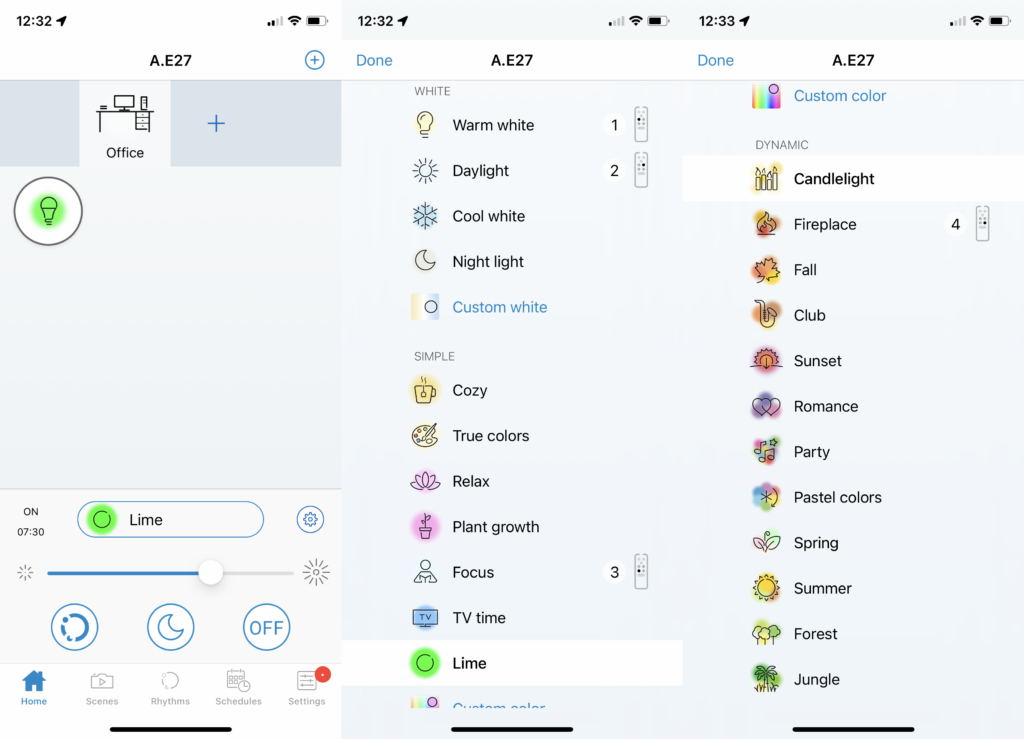
For utility, WiZ also has a Circadian Rhythm option. This lets y'all select the colour of the light during the day, starting with a colder low-cal from the wake-up fourth dimension you select, moving through to a warmer tone for the bedtime you set. In this way, you have more natural lighting that will more closely friction match that of daylight, although this feature isn't as sensitive as the like one on the Dyson Lightcycle Morph, which adjusts lite temperature based on your location and the time of year.
If you plow on the Rhythm option, then the app removes the 'On' button for your lights, replacing it with the Rhythm option instead. I'd like both options to be available, so I can choose betwixt only turning my lights on with the previous setting or pick the Circadian pick.
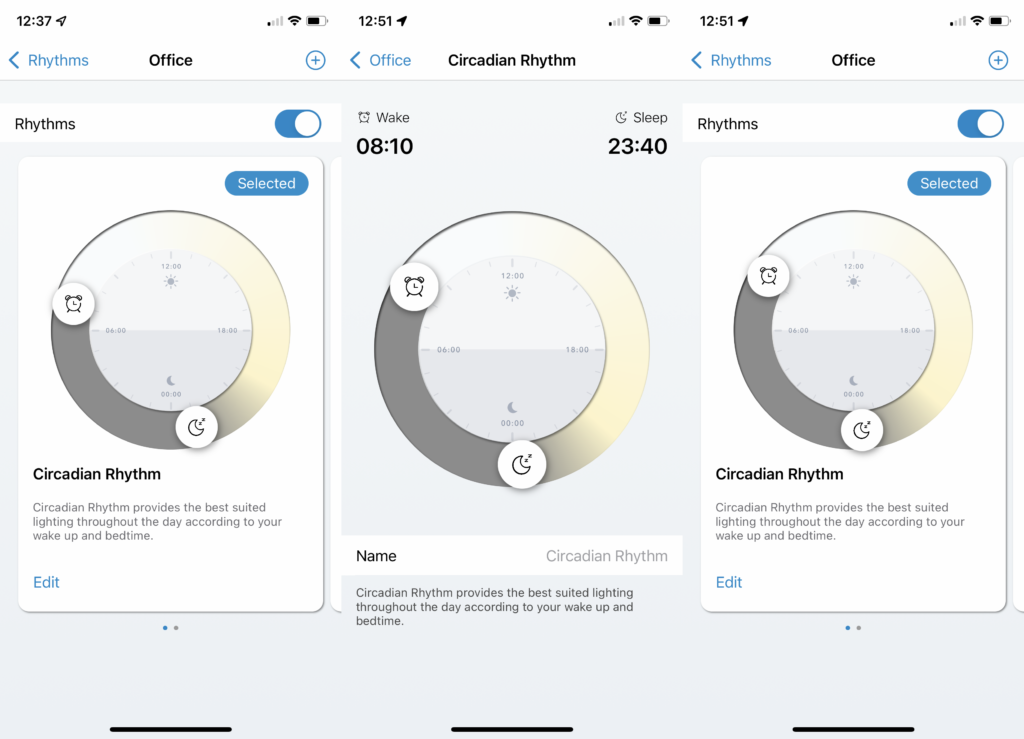
Scheduling is available through the app, letting y'all turn lights on and off at the times you select. There's no sunrise or dusk choice here, every bit you get with Hue, which may brand some routines difficult to create. For example, if you've got a calorie-free in a porch that yous desire to come up on at sunset and turn off at midnight, you can't do that easily with WiZ.
It's skillful to meet the fully automatic Vacation Style. Turn this on, and your smart lights will turn on and off automatically, simulating the presence of someone at home.
If y'all have a WiZmote, you can pair this with a unmarried room. Via the app, y'all can choose which sense the four shortcut buttons will trigger, plus the fade-in and fade-out times for the on/off buttons. The latter sets how long it takes lights to turn on or off, although I'chiliad not particularly convinced how useful existence able to adjust this setting really is.
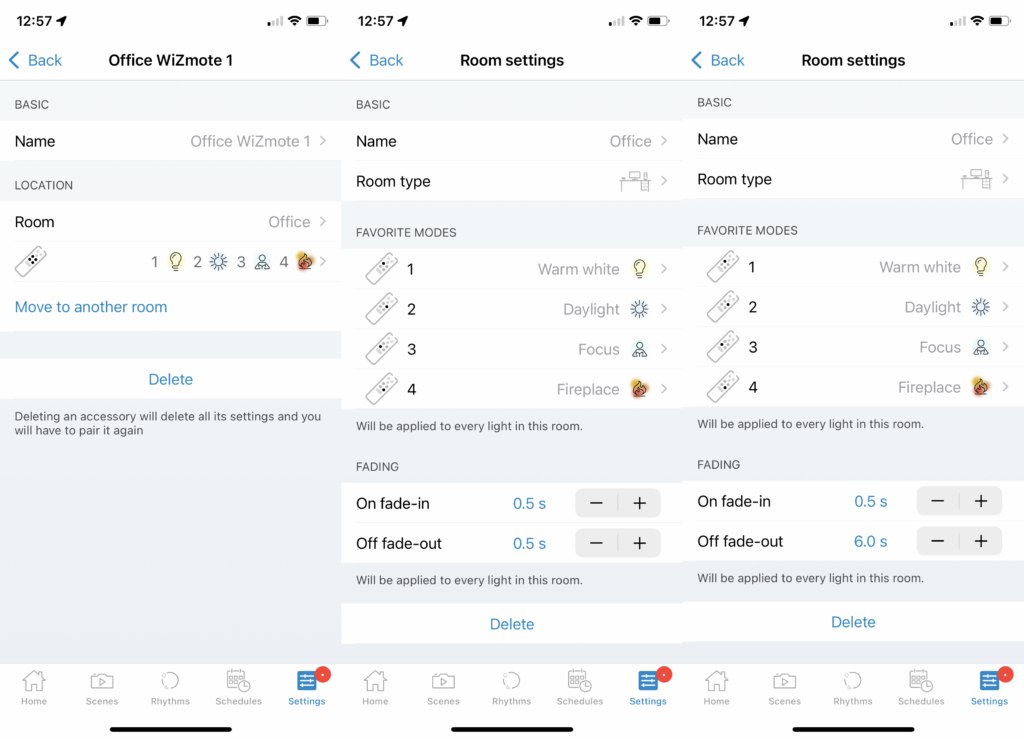
It's adept to see that there are tunable options to ready how bulbs work when switched on and off at the light switch. The default mode is WiZclick, which lets you set a default light mode for the first switch, plus a secondary mode if you quickly toggle the light switch once more. With this fashion, you can turn your light switch into a smart one, say one click for a regular light and two clicks for mood lighting. If you don't like this, you can use the Terminal condition pick, where your bulbs turn on with the last setting y'all used in the app.
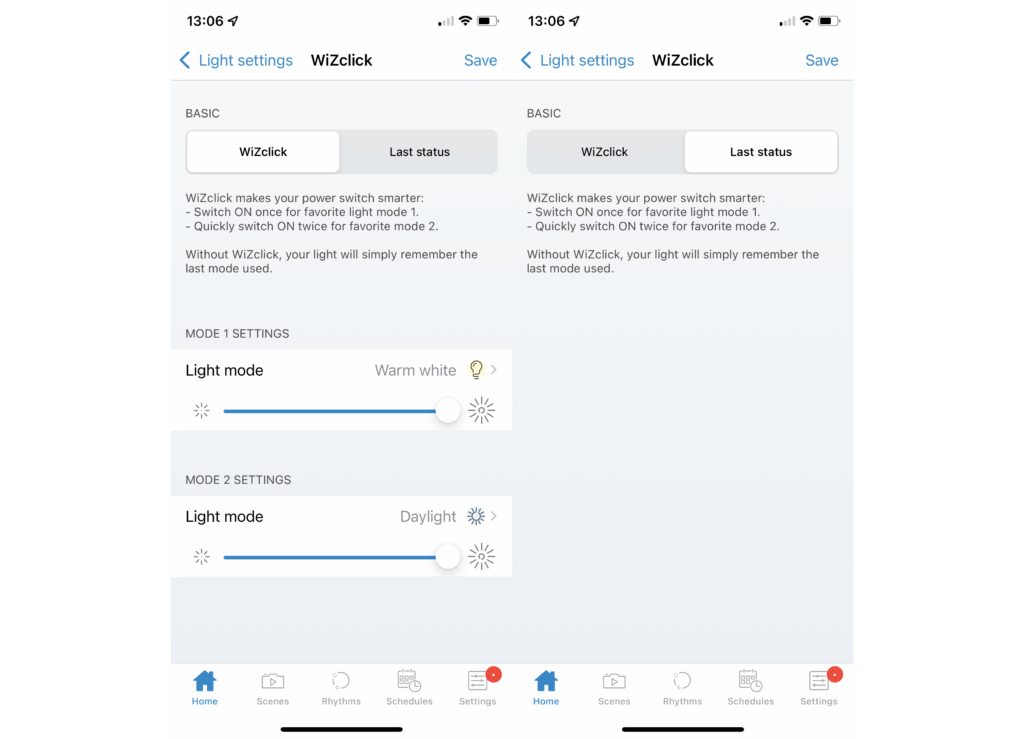
Amazon Alexa and Google Assistant support are bachelor, giving you voice command over your lights, including setting colours, scenes and brightness. At that place's no direct HomeKit support, although Siri shortcuts on iPhone are supported. If you exercise want HomeKit compliant lights, you'll need a Hue system with a Bridge.
Samsung SmartThings support is available. That'southward handy if you use that system for your automations, and further expands the scope of the WiZ organisation.
Performance
- Lights reply quickly
- WiZmote operates without Wi-Fi
- Not quite as bright as Hue bulbs
As the WiZ bulbs utilise Wi-Fi to connect, they tin can be a bit ho-hum to register in the app if they've been turned off at the calorie-free switch: I plant that they could accept up to 30 seconds to appear, which is quite a lot slower than Hue bulbs have, with Zigbee being much faster and more reliable.
One time turned on, the WiZ bulbs are quick to respond to commands. Using the app to dim using the slider, I establish that my bulbs reacted quickly to the change, in virtually real-fourth dimension. In fact, there's very piddling, if whatever, deviation in performance here than when using Hue bulbs.
Every bit the WiZmote connects directly to lights, information technology'southward just every bit responsive to use as the Hue remotes and switches. Should your Wi-Fi become down, the WiZmote will continue to piece of work, so you can all the same adjust brightness and cycle through your selected scenes.
Testing with the WiZ A60 E27 Total Color seedling, I compared its functioning with the equivalent Hue bulb. Both bulbs put out like brightness when used with standard colour temperatures (warm white to cold white), with a similar dimming range (cosy to intense).
Colour reproduction is similar, besides, although I institute that the Hue bulb was capable of putting out a much stronger red than the WiZ bulb. That generally means that any colours that use a shade of red are that bit bolder with Hue.
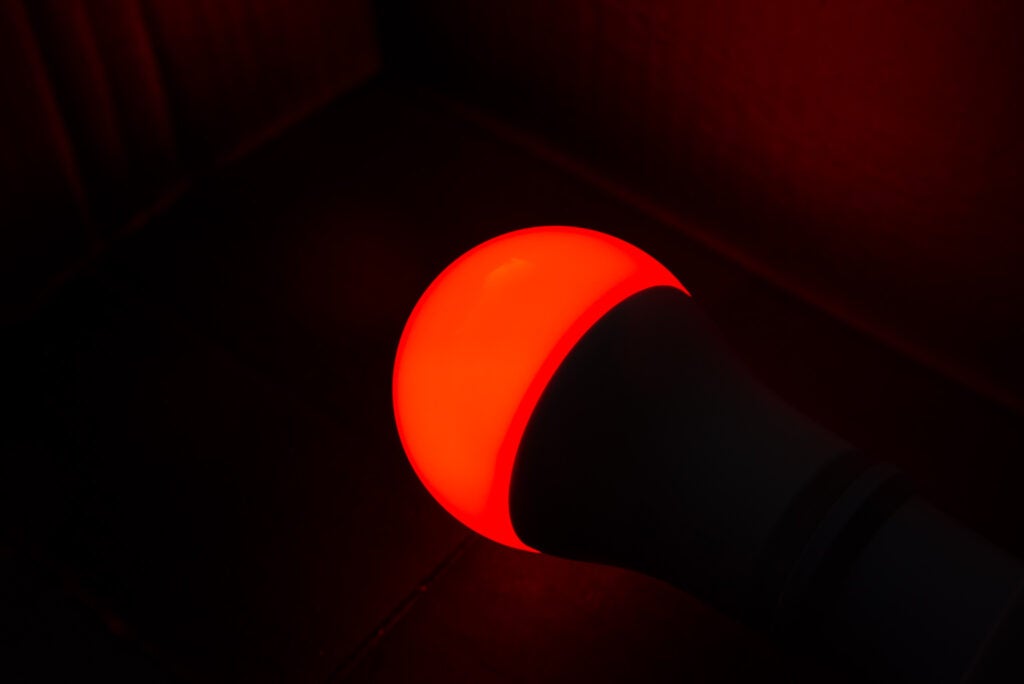
What I will say is that why the red may non exist every bit bold with WiZ, the colour range is withal very good and accuracy is very good.
Many cheap bulbs suffer at some point, but bated from a slightly weak yellowish, the WiZ seedling produces excellent colours.
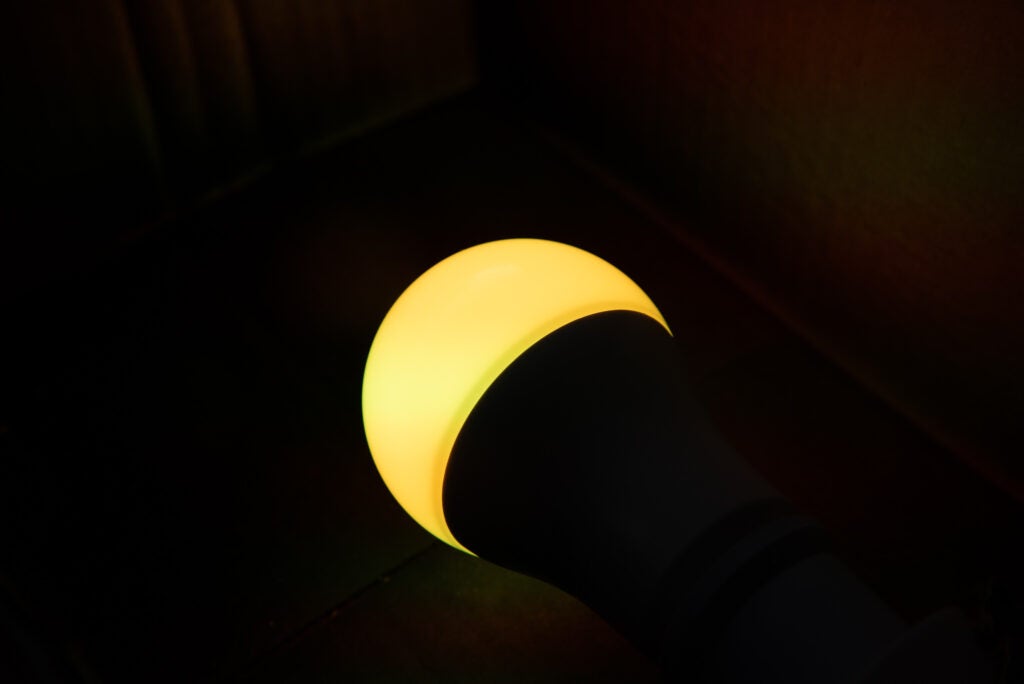
I as well tested the Filament amber bulb, which has a neat criss-crossing pattern of filaments inside an bister-colour shell. The result is that this really does await like an quondam fashioned bulb. Beingness able to change colour temperature is great, too, every bit y'all can go from an intense reading light downwards to a relaxing low-cal. Testing maximum effulgence, this seedling has similar performance to the colour bulbs in WiZ's range. That is, the filament bulbs tin supersede existing light bulbs.

Bulb life depends on the type, simply the range is between 15000 and 25000 hours. At eight hours per day, that works out at between 5 years and eight-and-a-half years of life, similar to the Hue range.
Latest deals
Should you buy it?
If you want a few smart bulbs around the house, with more than just app control on offer, the WiZ range is great value.
If yous want the absolute best colour product, the widest pick of lamps and more wireless controls, the Philips Hue system remains the best selection.
Final Thoughts
The upshot that I've had with cheaper Wi-Fi bulbs is that they've largely been limited to app or voice command, and the range is usually quite express. With the WiZ range, you become a huge option of bulbs, compatible with most fittings, and the pick of a motion sensor and remote control. With a decent app available, too, this is a great budget system for those that merely want a few smart bulbs around the house.
For larger installations and a wider range of controls, bulbs and lamps, the Hue system remains king, but information technology's far more expensive to get started with.
How we test
Unlike other sites, we test every smart light nosotros review thoroughly over an extended period of fourth dimension. We utilize industry standard tests to compare features properly. We'll ever tell you what nosotros notice. We never, ever, take money to review a production.
Discover out more than about how we examination in our ethics policy.
Used every bit our primary smart light for the review period
Tested for at least a week
We measure the light output from bulbs at different color temperatures and colours so we tin compare low-cal output
Nosotros test compatibility with the chief smart systems (HomeKit, Alexa, Google Assistant, SmartThings, IFTTT and more) to encounter how easy each light is to automate
You lot might like…
FAQs
How long do WiZ smart light bulbs last for?
Information technology depends on the type, only they generally last between xv,000 and 25,000 hours.
Practise WiZ bulbs piece of work with Hue?
No, WiZ bulbs are Wi-Fi and are controlled through a different app to Hue ones.
Full specs
‹
UK RRP
USA RRP
EU RRP
Manufacturer
Product Description
Release Date
Beginning Reviewed Engagement
Voice Assistant
Accessories
Networking
›
Jargon buster
Zigbee
A depression-power networking protocol for smart home devices, commonly used for smart lighting systems, such as Philips Hue. Zigbee devices require a bridge or hub for remote control.
Alexa
Amazon's smart voice assistant
Google Assistant
A vocalisation banana which is Google's have on Amazon's Alexa.
Source: https://www.trustedreviews.com/reviews/wiz-smart-lighting
Posted by: hoganalicinte.blogspot.com


0 Response to "WiZ Smart Lighting Review: Low cost, lots of features"
Post a Comment